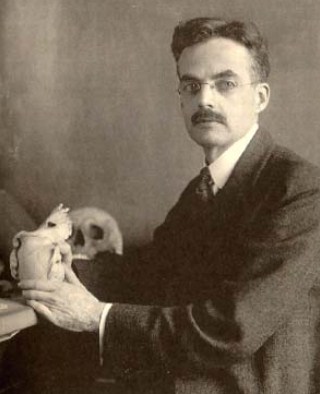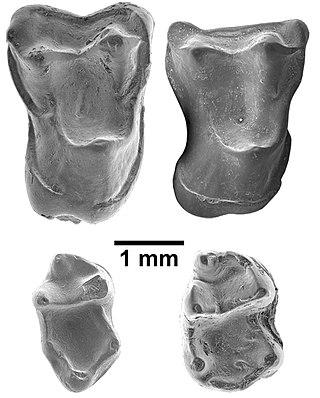
Henry Fairfield Osborn, Sr. was an American paleontologist, geologist and eugenics advocate. He was the president of the American Museum of Natural History for 25 years and a cofounder of the American Eugenics Society.

Haplorhini, the haplorhines or the "dry-nosed" primates is a suborder of primates containing the tarsiers and the simians, as sister of the Strepsirrhini ("moist-nosed"). The name is sometimes spelled Haplorrhini. The simians include catarrhines, and the platyrrhines.
Paleoanthropology or paleo-anthropology is a branch of paleontology and anthropology which seeks to understand the early development of anatomically modern humans, a process known as hominization, through the reconstruction of evolutionary kinship lines within the family Hominidae, working from biological evidence and cultural evidence.

The simians, anthropoids, or higher primates are an infraorder of primates containing all animals traditionally called monkeys and apes. More precisely, they consist of the parvorders Platyrrhini and Catarrhini, the latter of which consists of the family Cercopithecidae and the superfamily Hominoidea.

Aegyptopithecus is an early fossil catarrhine that predates the divergence between hominoids (apes) and cercopithecids. It is known from a single species, Aegyptopithecus zeuxis, which lived around 38-29.5 million years ago in the early part of the Oligocene epoch. It likely resembled modern-day New World monkeys, and was about the same size as a modern howler monkey, which is about 56 to 92 cm long. Aegyptopithecus fossils have been found in the Jebel Qatrani Formation of modern-day Egypt. Aegyptopithecus is believed to be a stem-catarrhine, a crucial link between Eocene and Miocene fossils.

The Taung Child is the fossilised skull of a young Australopithecus africanus. It was discovered in 1924 by quarrymen working for the Northern Lime Company in Taung, South Africa. Raymond Dart described it as a new species in the journal Nature in 1925.

Eosimias is a genus of early primates, first discovered and identified in 1999 from fossils collected in the Shanghuang fissure-fillings of Liyang, the southern city of Jiangsu Province, China. It is a part of the family Eosimiidae, and includes three known species: Eosimias sinensis, Eosimias centennicus, and Eosimias dawsonae. It provides us with a glimpse of a primate skeleton similar to that of the common ancestor of the Haplorhini. The name Eosimias is designed to mean "dawn monkey", from Greek eos "dawn" and Latin simius "monkey".

The genus Apidium is that of at least three extinct primates living in the early Oligocene, from 30 to 28 million years ago. Apidium fossils are common in the Fayoum deposits of Egypt. Fossils of the earlier species, Apidium moustafai, are rare; fossils of the later species Apidium phiomense are fairly common.

William King Gregory was an American zoologist, renowned as a primatologist, paleontologist, and functional and comparative anatomist. He was an expert on mammalian dentition, and a leading contributor to theories of evolution. In addition he was active in presenting his ideas to students and the general public through books and museum exhibits.

Catopithecus is an early catarrhine fossil. It is known from more than 16 specimens of a single species, Catopithecus browni, found in the Jebel Qatrani Formation of the Fayum Province, Egypt. The Jebel Qatrani Formation has been divided into two main faunal zones based on the fact that the fauna found in the lower portion of the quarry appear to be more primitive than those found in the upper section. The upper zone has been dated to older than 31 ± 1 myr based on the dating of a basalt layer that lies immediately above the formation and Nicolas Steno’s Law of Superposition. The lower zone contains the late Eocene green shale unit called Locality-41 (L-41) in which all the specimens of Catopithecus browni have been found. The relative dating of L-41 based on paleomagnetic correlations places it at 36 Myr according to Simons et al (1999), but Seiffert (2006) suggests this should be revised to 34.8-33.9 Myr.

Darwinius is a genus within the infraorder Adapiformes, a group of basal strepsirrhine primates from the middle Eocene epoch. Its only known species, Darwinius masillae, lived approximately 47 million years ago based on dating of the fossil site.
Algeripithecus is an extinct genus of early fossil primate, weighing approximately 65 to 85 grams. Fossils have been found in Algeria dating from 50 to 46 million years ago.

Afrasia djijidae is a fossil primate that lived in Myanmar approximately 37 million years ago, during the late middle Eocene. The only species in the genus Afrasia, it was a small primate, estimated to weigh around 100 grams (3.5 oz). Despite the significant geographic distance between them, Afrasia is thought to be closely related to Afrotarsius, an enigmatic fossil found in Libya and Egypt that dates to 38–39 million years ago. If this relationship is correct, it suggests that early simians dispersed from Asia to Africa during the middle Eocene and would add further support to the hypothesis that the first simians evolved in Asia, not Africa. Neither Afrasia nor Afrotarsius, which together form the family Afrotarsiidae, is considered ancestral to living simians, but they are part of a side branch or stem group known as eosimiiforms. Because they did not give rise to the stem simians that are known from the same deposits in Africa, early Asian simians are thought to have dispersed from Asia to Africa more than once prior to the late middle Eocene. Such dispersals from Asia to Africa also were seen around the same time in other mammalian groups, including hystricognathous rodents and anthracotheres.
Plesiopithecus is an extinct genus of early strepsirrhine primate from the late Eocene.

The evolutionary history of the primates can be traced back 57-90 million years. One of the oldest known primate-like mammal species, Plesiadapis, came from North America; another, Archicebus, came from China. Other similar basal primates were widespread in Eurasia and Africa during the tropical conditions of the Paleocene and Eocene. Purgatorius is the genus of the four extinct species believed to be the earliest example of a primate or a proto-primate, a primatomorph precursor to the Plesiadapiformes, dating to as old as 66 million years ago.
The Amphipithecidae were simian primates that lived in Late Eocene and Early Oligocene. Fossils have been found in Myanmar, Thailand, and Pakistan. The limited fossil evidence is consistent with, but not exclusive to, arboreal quadrupedalism. In other words, the species may have moved about in trees on four legs, but not with regular leaping as seen in later simians.
Phileosimias is an extinct genus of primates with two species, P. kamli and P. bahuiorum, that are believed to be amongst the early simians.

"Missing link" is a hypothetical or recently-discovered transitional fossil. It is often used in popular science and in the media for any new transitional form. The term originated to describe the hypothetical intermediate form in the evolutionary series of anthropoid ancestors to anatomically modern humans (hominization). The term was influenced by the pre-Darwinian evolutionary theory of the Great Chain of Being and the now-outdated notion (orthogenesis) that simple organisms are more primitive than complex organisms.
Kapi is an extinct primate genus that lived in northern India about 13.8 to 12.5 million years ago during the Miocene. The only species, K. ramnagarensis, was described in 2020 and is known from a complete lower molar. The fossil was discovered in 2015 from Ramnagar, a town in Jammu and Kashmir, for which the species name was created. Though originally identified as member of the gibbons and popularised in the news as the oldest gibbon, it was later reassessed as those of pliopithecoid, a group of extinct Old World monkeys.
Prosthennops is a genus of extinct peccaries that lived in North and Central America between the middle Miocene and lower Pliocene.














